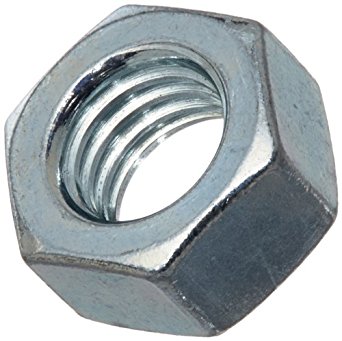Types of nuts
A nut is a fastener that consists of a block with a threaded hole in the centre. The hole contains ‘female’ threads that typically correspond to the ‘male’ threads of a bolt or screw. Nuts are used with their ‘mating’ bolt or screw to fasten materials together.
The most common shape for a nut is hexagonal, as six sides provide more angles for a tool to approach from, although the corners can be more vulnerable to becoming rounded off over time which makes them less easy to use with tools. Square nuts can also be used but are less common.
Vibration or rotation can have the effect of loosening a nut over time and so different locking mechanisms can be used, including:
Nuts are used for many different applications and so there are a wide variety of different types. Some of these include:
- Basic hex nut: A six-sided nut, and the most common type. There are several variations such as the nylon insert lock which helps secure the nut in place.
- Wing nut: The head of a wing nut has two ‘wings’ on each side, enabling it to be tightened and loosened by hand. Mainly used for temporary fastening.
- Cap nut: This type of nut is closed at one end with a smooth-domed top.
- Acorn nut: Similar to a cap nut but the rounded end has a higher crown.
- Barrel nut: Also known as a dowel nut, this has a round ‘slug’ with threads perpendicular to its length.
- Cage nut: A spring steel cage wraps around the nut with wings that can be used to compress and release the nut.
- Coupling nut: A threaded fastener for joining two male threads together, such as in pipework, or to make long rod assemblies from shorter lengths.
- Flange nut: A wide flange at one end acts as an integrated washer, distributing the pressure of the nut over the part being secured.
- Insert nut: Inserted into a pre-drilled hole to provide a threaded socket.
- Split nut: Split into two pieces to allow the female thread to open and close over the male thread of a bolt or screw.
- Square nut: A four-sided nut which provides greater resistance to loosening.
- Swage nut: Also known as a self-clinching nut, this is used to permanently anchor itself onto sheet metal.
- T-nut: A long, thin body with a T-shaped flange at one end which digs in, leaving a flush surface.
- Weld nut: A specialised nut that can be welded to another component.
[edit] Related articles on Designing Buildings Wiki
- Clamp.
- Construction equipment.
- Construction staples.
- Construction tools.
- Crimp.
- Furniture, fixtures and equipment.
- Nails - a brief history.
- Off-site prefabrication of buildings: A guide to connection choices.
- Rivet.
- Staple.
- Strap.
- Structural fasteners.
- Structural steelwork.
- Types of bolts.
- Types of fixings.
- Types of nails.
- Types of screws.
Featured articles and news
A change to adoptive architecture
Effects of global weather warming on architectural detailing, material choice and human interaction.
How big is the problem and what can we do to mitigate the effects?
Overheating guidance and tools for building designers
A number of cool guides to help with the heat.
The UK's Modern Industrial Strategy: A 10 year plan
Previous consultation criticism, current key elements and general support with some persisting reservations.
Building Safety Regulator reforms
New roles, new staff and a new fast track service pave the way for a single construction regulator.
Architectural Technologist CPDs and Communications
CIAT CPD… and how you can do it!
Cooling centres and cool spaces
Managing extreme heat in cities by directing the public to places for heat stress relief and water sources.
Winter gardens: A brief history and warm variations
Extending the season with glass in different forms and terms.
Restoring Great Yarmouth's Winter Gardens
Transforming one of the least sustainable constructions imaginable.
Construction Skills Mission Board launch sector drive
Newly formed government and industry collaboration set strategy for recruiting an additional 100,000 construction workers a year.
New Architects Code comes into effect in September 2025
ARB Architects Code of Conduct and Practice available with ongoing consultation regarding guidance.
Welsh Skills Body (Medr) launches ambitious plan
The new skills body brings together funding and regulation of tertiary education and research for the devolved nation.
Paul Gandy FCIOB announced as next CIOB President
Former Tilbury Douglas CEO takes helm.
UK Infrastructure: A 10 Year Strategy. In brief with reactions
With the National Infrastructure and Service Transformation Authority (NISTA).
Ebenezer Howard: inventor of the garden city. Book review.
Airtightness Topic Guide BSRIA TG 27/2025
Explaining the basics of airtightness, what it is, why it's important, when it's required and how it's carried out.























Comments
Wow, Nice blog. keep it up.
https://www.dicfasteners.com/wing-nuts.php